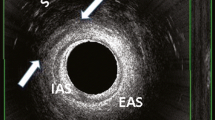Abstract
Introduction and hypothesis
We compared the clinician’s ability to cut episiotomies at the recommended 60° angle with traditional straight Mayo scissors compared with patented fixed-angle episiotomy scissors EPISCISSORS-60® in a simulated setting using mounted incision pads. The hypothesis was that fixed-angle episiotomies would achieve a more accurate cutting angle of 60°.
Methods
Angles were cut on episiotomy incision pads in a mounted birth model simulating crowning: 110 midwives and doctors cut an 60° episiotomy with Mayo scissors and then EPISCISSORS-60. Angles were measured with protractors. Average angles were calculated and the one-tailed paired t test was used to compare groups.
Results
Mean angle was 45° with Mayo scissors [SD = 9, 95% confidence interval (CI) = 43.3–46.7, interquartile range (IQR) 38–50] and 60° with the EPISCISSORS-60 (SD = 3, 95% CI = 59.3–60.7, IQR = 58–60). Two-thirds of cuts with Mayo scissors were below 50°.
Conclusions
In a simulated setting the majority of operators are unable to cut an episiotomy at the recommended 60° angle with Mayo scissors. The EPISCISSORS-60 cut an episiotomy a statistically significant 15° wider than regular Mayo scissors and achieved the recommended 60° in the vast majority of cases. If these findings translate into real life situations, then cutting episiotomies at 60° is expected to make a valuable contribution in reducing third- and fourth-degree tears in both spontaneous and operative vaginal deliveries. Variability in mediolateral episiotomies should be reduced by use of fixed-angle scissors or through validated health professional training programmes to improve visual accuracy.

Similar content being viewed by others
References
Gurol-Urganci I, Cromwell DA, Edozien LC, Mahmood TA, Adams EJ, Richmond DH. Third- and fourth-degree perineal tears among primiparous women in England between 2000 and 2012: time trends and risk factors. BJOG. 2013;120:1516–25.
Richter HE, Nager CW, Burgio KL, et al. Incidence and predictors of anal incontinence after obstetric anal sphincter injury in primiparous women. Female Pelvic Med Reconstr Surg. 2015;21:182–9.
Fitzpatrick M, O’Herlihy C. Short-term and long-term effects of obstetric anal sphincter injury and their management. Curr Opin Obstet Gynecol. 2005;17:605–10.
Oberwalder M, Connor J, Wexner SD. Meta-analysis to determine the incidence of obstetric anal sphincter damage. Br J Surg. 2003;90:1333–7.
Keighley MR, Perston Y, Bradshaw E, Hayes J, Keighley DM, Webb S. The social, psychological, emotional morbidity and adjustment techniques for women with anal incontinence following Obstetric Anal Sphincter Injury: use of a word picture to identify a hidden syndrome. BMC Pregnancy Childbirth. 2016;16(1):275.
Signorello L, Harlow B, Chekos A, Repke J. Postpartum sexual functioning and its relationship to perineal trauma: a retrospective cohort study of primiparous women. Am J Obstet Gynecol. 2001;184:881–90.
Macarthur AJ, Macarthur C. Incidence, severity and determinants of perineal pain after vaginal delivery: a prospective cohort study. Am J Obstet Gynecol. 2004;191(4):1199–204.
National Health Service Litigation Authority. Ten years of maternity claims: an analysis of NHS litigation authority data. NHSLA, 2012.
RCOG Greentop guideline 29: the management of Third- and Fourth-Degree Perineal tears: RCOG June 2015. www.rcog.org.uk.
Coats PM, Chan KK, Wilkins M, Beard RJ. A comparison between midline and mediolateral episiotomies. Br J Obstet Gynaecol. 1980;87:408–12.
Signorello LB, Harlow BL, Chekos AK, Repke JT. Midline episiotomy and anal incontinence: retrospective cohort study. Br Med J. 2000;320(7227):86–90.
Kalis V, Karbanova J, Horak M, et al. The incision angle of mediolateral episiotomy before and after repair. Int J Gynaecol Obstet. 2008;103:5–8.
Stedenfeldt M, Pirhonen J, Blix E, Wilsqaard T, Vonen B, Qian P. Episiotomy characteristics and risks for obstetric anal sphincter injury: a case–control study. BJOG. 2012;119:724–30.
Eogan M, Daly L, O’Connell PR, O’Herlihy C. Does the angle of episiotomy affect the incidence of anal sphincter injury? BJOG. 2006;113:190–4.
Kalis V, Landsmanova J, Bednarova B, et al. Evaluation of the incision angle of mediolateral episiotomy at 60 degrees. Int J Gynaecol Obstet. 2011;112:220–4.
Silf K, Woodhead N, Kelly J, Fryer A, Kettle C, Ismail KMK. Evaluation of accuracy of mediolateral episiotomy incisions using a training model. Midwifery. 2015;31(1):197–200
Naidu M, Kapoor DS, Evans S, Vinayakarao L, Thakar R, Sultan AH. Cutting an episiotomy at 60 degrees: how good are we? Int Urogynecol J. 2015;26(6):813–6
Andrews V, Thakar R, Sultan AH, Jones PW. Are mediolateral episiotomies actually mediolateral? BJOG. 2005;112:1156–8.
Van Roon Y, Kirwin C, Rahman N, Vinayakarao L, Kester N, Pathak S, et al. Comparison of obstetric anal sphincter injuries in nulliparous women before and after introduction of the EPISCISSORS-60® at two hospitals in the United Kingdom. Int J Womens Health. 2015;7:949–55.
Author information
Authors and Affiliations
Corresponding author
Ethics declarations
Conflict of interest
None.
Rights and permissions
About this article
Cite this article
van Roon, Y., Vinayakarao, L., Melson, L. et al. Comparative study of episiotomy angles achieved by cutting with straight Mayo scissors and the EPISCISSORS-60 in a birth simulation model. Int Urogynecol J 28, 1063–1066 (2017). https://doi.org/10.1007/s00192-016-3227-x
Received:
Accepted:
Published:
Issue Date:
DOI: https://doi.org/10.1007/s00192-016-3227-x




